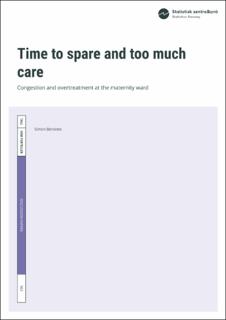| dc.contributor.author | Bensnes, Simon Søbstad | |
| dc.date.accessioned | 2021-10-05T13:23:40Z | |
| dc.date.available | 2021-10-05T13:23:40Z | |
| dc.date.issued | 2021-09 | |
| dc.identifier.issn | 1892-753X | |
| dc.identifier.uri | https://hdl.handle.net/11250/2787796 | |
| dc.description.abstract | Identifying the causal effect of resource use on health outcomes is generally complicated by endogenous supply and demand adjustments. This paper tackles these issues in the setting of the maternity ward using the number of women in local areas with the same due date as an instrument for congestion. I find that congestion leads to both fewer and less invasive interventions and better health outcomes, indicating medical overtreatment during slower periods. I also show that absent instrumentation I find similar results and similar signs of bias as the related literature on congestion in maternity wards. | en_US |
| dc.language.iso | eng | en_US |
| dc.publisher | Statistisk sentralbyrå | en_US |
| dc.relation.ispartofseries | Discussion Paper;No. 963 | |
| dc.rights | Navngivelse-DelPåSammeVilkår 4.0 Internasjonal | * |
| dc.rights.uri | http://creativecommons.org/licenses/by-sa/4.0/deed.no | * |
| dc.subject | Healthcare | en_US |
| dc.subject | Crowdedness | en_US |
| dc.subject | Congestion | en_US |
| dc.subject | Maternity | en_US |
| dc.title | Time to spare and too much care: Congestion and overtreatment at the maternity ward | en_US |
| dc.type | Working paper | en_US |
| dc.source.pagenumber | 61 | en_US |
| dc.relation.project | Norges Forskningsråd: 256678 | en_US |

